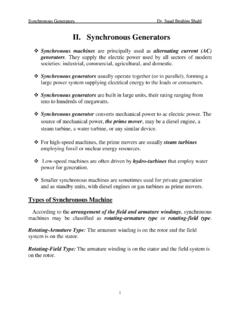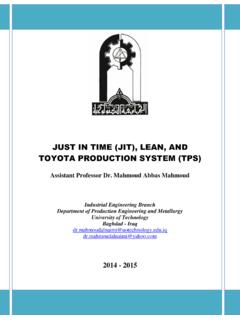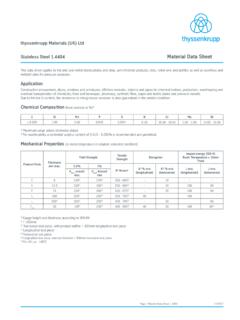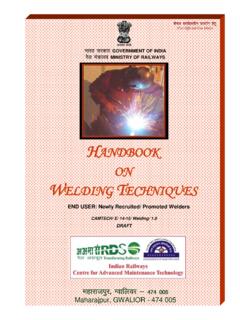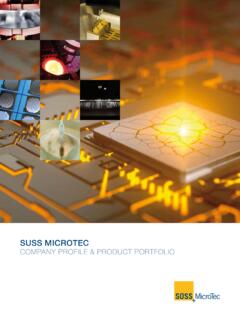Transcription of FUNDAMENTALS OF WELDING - University of Technology, …
1 1 FUNDAMENTALS OF WELDING 1- INTRODUCTION The term joining is generally used for WELDING , brazing, soldering, and adhesive bonding, which form a permanent joint between the parts a joint that cannot easily be separated. The term assembly usually refers to mechanical methods of fastening parts together. Some of these methods allow for easy disassembly, while others do not. We begin our coverage of the joining and assembly processes with WELDING , WELDING is a materials joining process in which two or more parts are coalesced at their contacting surfaces by a suitable application of heat and/or pressure. Many WELDING processes are accomplished by heat alone, with no pressure applied; others by a combination of heat and pressure; and still others by pressure alone, with no external heat supplied.
2 In some WELDING processes a filler material is added to facilitate coalescence. The assemblage of parts that are joined by WELDING is called a weldment. WELDING is most commonly associated with metal parts, but the process is also used for joining plastics. Our discussion of WELDING will focus on metals. WELDING is a relatively new process (Historical Note ). Its commercial and technological importance derives from the following: 1- WELDING provides a permanent joint. The welded parts become a single entity. 2- The welded joint can be stronger than the parent materials if a filler metal is used that has strength properties superior to those of the parents, and if proper WELDING techniques are used.
3 3- WELDING is usually the most economical way to join components in terms of material usage and fabrication costs. Alternative mechanical methods of assembly require more complex shape alterations ( , drilling of holes) and addition of fasteners ( , rivets or bolts). The resulting mechanical assembly is usually heavier than a corresponding weldment. 4- WELDING is not restricted to the factory environment. It can be accomplished in the field. Although WELDING has the advantages indicated above, it also has certain limitations and drawbacks (or potential drawbacks): 1- Most WELDING operations are performed manually and are expensive in terms of labor cost.
4 Many WELDING operations are considered skilled trades, and the labor to perform these operations may be scarce. 2- Most WELDING processes are inherently dangerous because they involve the use of high energy. 3- Since WELDING accomplishes a permanent bond between the components, it does not allow for convenient disassembly. If the product must occasionally be disassembled ( , for repair or maintenance), then WELDING should not be used as the assembly method. 4- The welded joint can suffer from certain quality defects that are difficult to detect. The defects can reduce the strength of the joint. OVIEW OF WELDING TECNOLOGY WELDING involves localized coalescence or joining together of two metallic parts at their faying surfaces.
5 The faying surfaces are the part surfaces in contact or close proximity that are to be joined. WELDING is usually performed on parts made of the same metal, but some WELDING operations can be used to join dissimilar metals. 2- TYPES OF WELDING PROCESSES Some 50 different types of WELDING operations have been cataloged by the American WELDING Society. They use various types or combinations of energy to provide the required power. We can divide the WELDING processes into two major groups: (1) fusion WELDING and (2) solid-state WELDING . 1-Fusion WELDING Fusion- WELDING processes use heat to melt the base metals. In many fusion WELDING operations, a filler metal is added to the molten pool to facilitate the process and provide bulk and strength to the 2 welded joint.
6 A fusion- WELDING operation in which no filler metal is added is referred to as an autogenous weld. The fusion category includes the most widely used WELDING processes, which can be organized into the following general groups (initials in parentheses are designations of the American WELDING Society): Arc WELDING (AW).Arc WELDING refers to a group of WELDING processes in which heating of the metals is accomplished by an electric arc, as shown in Figure 1. Some arc WELDING operations also apply pressure during the process and most utilize a filler metal. Resistance WELDING (RW). Resistance WELDING achieves coalescence using heat from electrical resistance to the flow of a current passing between the faying surfaces of two parts held together under pressure.
7 Included spot WELDING and seam WELDING , two joining methods widely used today in sheet metal working. Oxyfuel gas WELDING (OFW). These joining processes use an oxyfuel gas, such as a mixture of oxygen and acetylene, to produce a hot flame for melting the base metal and filler metal, if one is used. Although Davy discovered acetylene gas early in the 1800s, oxyfuel gas WELDING required the subsequent development of torches for combining acetylene and oxygen around 1900. During the 1890s, hydrogen and natural gas were mixed with oxygen for WELDING , but the oxyacetylene flame achieved significantly higher temperatures . These three WELDING processes arc WELDING , resistance WELDING , and oxyfuel gas WELDING constitute by far the majority of WELDING operations performed today.
8 Figure 1 Basics of arc WELDING : (1) before the weld; (2) during the weld (the base metal is melted and filler metal is added to the molten pool); and (3) the completed weldment. There are many variations of the arc- WELDING process. Other fusion- WELDING processes. Other WELDING processes that produce fusion of the metals joined include electron beam WELDING and laser beam WELDING . Certain arc and oxyfuel processes are also used for cutting metals. 2- Solid-State WELDING Solid-state WELDING refers to joining processes in which coalescence results from application of pressure alone or a combination of heat and pressure. If heat is used, the temperature in the process is below the melting point of the metals being welded.
9 No filler metal is utilized. Representative WELDING processes in this group include: Diffusion WELDING (DFW). Two surfaces are held together under pressure at an elevated temperature and the parts coalesce by solid-state diffusion. Friction WELDING (FRW). Coalescence is achieved by the heat of friction between two surfaces. 3 Ultrasonic WELDING (USW). Moderate pressure is applied between the two parts and an oscillating motion at ultrasonic frequencies is used in a direction parallel to the contacting surfaces. The combination of normal and vibratory forces results in shear stresses that remove surface films and achieve atomic bonding of the surfaces. 3- WELDING AS A COMMERCIAL OPERATION The principal applications of WELDING are (1) construction, such as buildings and bridges; (2) piping, pressure vessels, boilers, and storage tanks; (3) shipbuilding; (4) aircraft and aerospace; and (5) automotive and railroad.
10 WELDING is performed in a variety of locations and in a variety of industries. Owing to its versatility as an assembly technique for commercial products, many WELDING operations are performed in factories. However, several of the traditional processes, such as arc WELDING and oxyfuel gas WELDING , use equipment that can be readily moved, so these operations are not limited to the factory. They can be performed at construction sites, in shipyards, at customers plants, and in automotive repair shops. Most WELDING operations are labor intensive. For example, arc WELDING is usually performed by a skilled worker, called a welder, who manually controls the path or placement of the weld to join individual parts into a larger unit.
